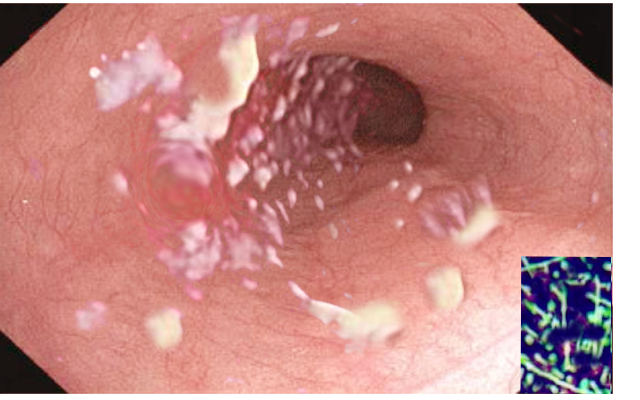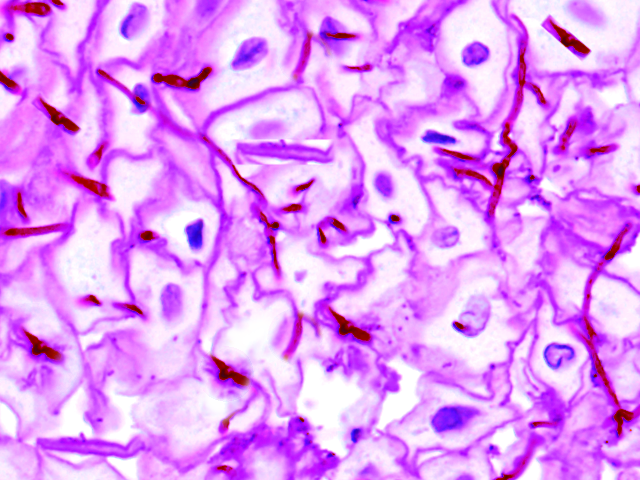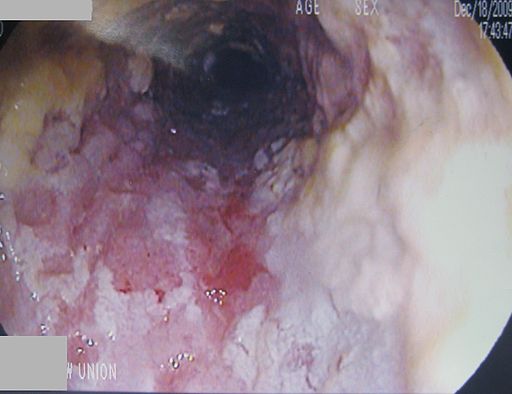[1]
Rosołowski M, Kierzkiewicz M. Etiology, diagnosis and treatment of infectious esophagitis. Przeglad gastroenterologiczny. 2013:8(6):333-7. doi: 10.5114/pg.2013.39914. Epub 2013 Dec 30
[PubMed PMID: 24868280]
[2]
Alsomali MI, Arnold MA, Frankel WL, Graham RP, Hart PA, Lam-Himlin DM, Naini BV, Voltaggio L, Arnold CA. Challenges to "Classic" Esophageal Candidiasis: Looks Are Usually Deceiving. American journal of clinical pathology. 2017 Jan 1:147(1):33-42. doi: 10.1093/ajcp/aqw210. Epub
[PubMed PMID: 28158394]
[3]
Takahashi Y,Nagata N,Shimbo T,Nishijima T,Watanabe K,Aoki T,Sekine K,Okubo H,Watanabe K,Sakurai T,Yokoi C,Kobayakawa M,Yazaki H,Teruya K,Gatanaga H,Kikuchi Y,Mine S,Igari T,Takahashi Y,Mimori A,Oka S,Akiyama J,Uemura N, Long-Term Trends in Esophageal Candidiasis Prevalence and Associated Risk Factors with or without HIV Infection: Lessons from an Endoscopic Study of 80,219 Patients. PloS one. 2015;
[PubMed PMID: 26208220]
[4]
Choi JH, Lee CG, Lim YJ, Kang HW, Lim CY, Choi JS. Prevalence and risk factors of esophageal candidiasis in healthy individuals: a single center experience in Korea. Yonsei medical journal. 2013 Jan 1:54(1):160-5. doi: 10.3349/ymj.2013.54.1.160. Epub
[PubMed PMID: 23225813]
[5]
Walsh TJ, Hamilton SR, Belitsos N. Esophageal candidiasis. Managing an increasingly prevalent infection. Postgraduate medicine. 1988 Aug:84(2):193-6, 201-5
[PubMed PMID: 3041396]
[6]
Klotz SA. Oropharyngeal candidiasis: a new treatment option. Clinical infectious diseases : an official publication of the Infectious Diseases Society of America. 2006 Apr 15:42(8):1187-8
[PubMed PMID: 16575740]
[7]
Pappas PG, Kauffman CA, Andes DR, Clancy CJ, Marr KA, Ostrosky-Zeichner L, Reboli AC, Schuster MG, Vazquez JA, Walsh TJ, Zaoutis TE, Sobel JD. Clinical Practice Guideline for the Management of Candidiasis: 2016 Update by the Infectious Diseases Society of America. Clinical infectious diseases : an official publication of the Infectious Diseases Society of America. 2016 Feb 15:62(4):e1-50. doi: 10.1093/cid/civ933. Epub 2015 Dec 16
[PubMed PMID: 26679628]
Level 1 (high-level) evidence
[8]
Skiest DJ, Vazquez JA, Anstead GM, Graybill JR, Reynes J, Ward D, Hare R, Boparai N, Isaacs R. Posaconazole for the treatment of azole-refractory oropharyngeal and esophageal candidiasis in subjects with HIV infection. Clinical infectious diseases : an official publication of the Infectious Diseases Society of America. 2007 Feb 15:44(4):607-14
[PubMed PMID: 17243069]
[9]
Lake DE, Kunzweiler J, Beer M, Buell DN, Islam MZ. Fluconazole versus amphotericin B in the treatment of esophageal candidiasis in cancer patients. Chemotherapy. 1996 Jul-Aug:42(4):308-14
[PubMed PMID: 8804799]
[10]
de Wet NT, Bester AJ, Viljoen JJ, Filho F, Suleiman JM, Ticona E, Llanos EA, Fisco C, Lau W, Buell D. A randomized, double blind, comparative trial of micafungin (FK463) vs. fluconazole for the treatment of oesophageal candidiasis. Alimentary pharmacology & therapeutics. 2005 Apr 1:21(7):899-907
[PubMed PMID: 15801925]
Level 2 (mid-level) evidence
[11]
Benson CA, Kaplan JE, Masur H, Pau A, Holmes KK, CDC, National Institutes of Health, Infectious Diseases Society of America. Treating opportunistic infections among HIV-infected adults and adolescents: recommendations from CDC, the National Institutes of Health, and the HIV Medicine Association/Infectious Diseases Society of America. MMWR. Recommendations and reports : Morbidity and mortality weekly report. Recommendations and reports. 2004 Dec 17:53(RR-15):1-112
[PubMed PMID: 15841069]
[13]
Geagea A, Cellier C. Scope of drug-induced, infectious and allergic esophageal injury. Current opinion in gastroenterology. 2008 Jul:24(4):496-501. doi: 10.1097/MOG.0b013e328304de94. Epub
[PubMed PMID: 18622166]
Level 3 (low-level) evidence
[14]
Ostrosky-Zeichner L, Rex JH, Bennett J, Kullberg BJ. Deeply invasive candidiasis. Infectious disease clinics of North America. 2002 Dec:16(4):821-35
[PubMed PMID: 12512183]
[15]
Lee KJ, Choi SJ, Kim WS, Park SS, Moon JS, Ko JS. Esophageal Stricture Secondary to Candidiasis in a Child with Glycogen Storage Disease 1b. Pediatric gastroenterology, hepatology & nutrition. 2016 Mar:19(1):71-5. doi: 10.5223/pghn.2016.19.1.71. Epub 2016 Mar 22
[PubMed PMID: 27066451]
[16]
Aghdam MR, Sund S. Invasive Esophageal Candidiasis with Chronic Mediastinal Abscess and Fatal Pneumomediastinum. The American journal of case reports. 2016 Jul 8:17():466-71
[PubMed PMID: 27389822]
Level 3 (low-level) evidence



